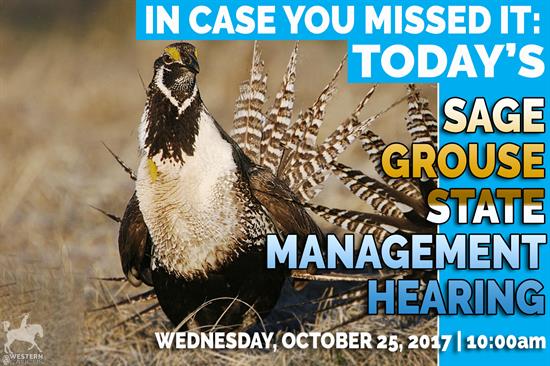From Today: House Natural Resources Holds Hearing on State-Level Sage Grouse Management
Washington,
October 25, 2017
This morning - Wednesday, October 25, 2017 at 10:00 a.m. in the House Natural Resources Committee room, the House Natural Resources Committee held a hearing discussing the ongoing success of Sage Grouse recovery efforts as well as the need for, and potential of, states and localities to boost recovery efforts with regionally-tailored plans.
Washington, D.C. – This morning - Wednesday, October 25, 2017 at 10:00 a.m. in the House Natural Resources Committee room, the House Natural Resources Committee held a hearing discussing the ongoing success of Sage Grouse recovery efforts as well as the need for, and potential of, states and localities to boost recovery efforts with regionally-tailored plans. * * * * * Courtesy House Committee on Natural Resources Today, the House Committee on Natural Resources held a hearing to review the success of Western State sage grouse management plans and the need for continued local control over sage grouse management. Western States sage grouse management plans have been the primary driver of improvements to the species range-wide. “[t]he federal government under the Obama administration insisted on managing Greater Sage Grouse recovery with a Washington, D.C., one-size-fits-all approach that fails miserably to address the individual management challenges present in each state. The purpose of today’s hearing is to provide further evidence that state and local control leads to lasting success. States have consistently proven to be masters at caring for their own lands and wildlife, and sage grouse is no different,” Chairman Rob Bishop (R-UT) said. In 2015, the U.S. Fish and Wildlife Service decided that listing the Greater Sage Grouse as either threatened or endangered under the Endangered Species Act was not warranted. Instead, the Obama administration developed an equally-restrictive de facto listing scheme by amending 98 Western resource management plans. “The Obama administration’s de facto sage grouse listing and the 20 year mineral moratorium on ten million acres of land has been one of the greatest threats to the livelihood of western communities. Some of the most stifling consequences of the Obama era regulations were targeted at businesses,” Rep. Paul Gosar (R-AZ) said. “Thankfully President Trump’s Department of [the] Interior cancelled the massive proposed withdrawal allowing job creators and hardrock miners to get back to work.” Decades of activist litigation and efforts by the Obama administration to circumvent successful state management plans have been “bad for the West, bad for jobs and bad for sage grouse,” according to Idaho Speaker of the House and fifth generation rancher Scott Bedke. “In the process of placating anti-grazing activists, federal agencies have made the number one threat to the Greater Sage Grouse in Idaho worse. In fact, these federal amendments, if left to stand, will create an explosive wildfire situation throughout the Great Basin,” Bedke added. In 2017, Bedke’s family ranch lost their entire winter grazing allotment due to overly prescriptive federal land use restrictions. A wildfire, which could have been easily contained by local firefighter, was allowed by federal managers to grow out of control burning tens of thousands of acres of prime sage grouse habitat. “My home state of Colorado has spent more than ten million dollars, set aside 130,000 acres for habitat and is developing a mitigation marketplace all for protecting the sage grouse,” Rep. Doug Lamborn (R-CO) said. State management plans have been developed with local stakeholders and experts on the ground for more than a decade to address unique and varying geographic differences within their boundaries. “It should be no surprise that Western States are actively implementing plans within their respective states that are having positive impacts on habitats,” Chairman of the Eureka County Nevada Commissioner, Vice Chair of the National Cattlemen’s Beef Association Federal Lands Committee and Fourth Generation Cattle Producer J.J. Goicoechea said. Utah, for example, spends an average of $5 million a year protecting sage grouse, and has seen the state population of sage grouse steadily increase since 1990. The state has been especially successful at mitigating the threat of catastrophic wildfire within sage grouse management areas. “I am here to do more than just share a feel good success story of a program that is working. I am here to protect these programs,” Deputy Director of the Utah Department of Natural Resources Darin Bird, in reference to the state’s management strategies, stressed. Similarly, in Montana, male sage grouse are up 153% compared to 2014 numbers due to the investment of almost $8 million in conservation funds in 2016 to restore over 1,000 acres of critical sage grouse habitat. Click here to view full witness testimony.
### |
Stay Connected
Use the following link to sign up for our newsletter and get the latest news and updates directly to your inbox.



